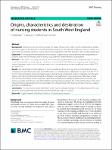Origins, characteristics and destination of nursing students in South West England
| dc.contributor.author | Hambridge, K | |
| dc.contributor.author | Banerjee, S | |
| dc.contributor.author | Winfield, L | |
| dc.contributor.author | Gripton, J | |
| dc.date.accessioned | 2023-04-17T10:33:51Z | |
| dc.date.available | 2023-04-17T10:33:51Z | |
| dc.date.issued | 2023-03-18 | |
| dc.identifier.issn | 1472-6955 | |
| dc.identifier.issn | 1472-6955 | |
| dc.identifier.other | 71 | |
| dc.identifier.uri | https://pearl.plymouth.ac.uk/handle/10026.1/20703 | |
| dc.description.abstract |
<jats:title>Abstract</jats:title><jats:sec> <jats:title>Background</jats:title> <jats:p>Worldwide there are concerns about the supply of nurses into health systems. Understanding and balancing the supply of and demand for healthcare professionals is crucial to efficient healthcare delivery, yet there is relatively little research that examines in detail where nursing students come from and where they go after qualification.</jats:p> </jats:sec><jats:sec> <jats:title>Objectives</jats:title> <jats:p>To investigate the demographic characteristics of applicants to nursing and midwifery programmes in England, those that are enrolled, attrition during study, and their career intentions on graduation.</jats:p> </jats:sec><jats:sec> <jats:title>Methods</jats:title> <jats:p>A descriptive case study was conducted in south west England drawing on a complementary set of analyses of routinely collected application and enrolment data from 2017–2020. These were augmented by derivation of student deprivation indices and a follow-up study of nursing and midwifery students qualifying between May 2020 and April 2021.</jats:p> </jats:sec><jats:sec> <jats:title>Results</jats:title> <jats:p>The percentage of males applying for nursing doubled and the mean age of all enrolled students (except midwifery) increased during the study period. The mean level of deprivation of applicants increased from the 51<jats:sup>st</jats:sup> to the 55<jats:sup>th</jats:sup> centile indicating widening of participation. Most applying and enrolled students originated from the same region as the nursing school and remained working there on qualification. Successively more males than females were lost from the system at each stage from application to qualification. Qualifying students most common job choice was within acute Trusts, with Medical, District nursing and surgical being the most common choices. The most important factors regarding job choice were location, the characteristics of the Trust, having been there as a student, and family considerations.</jats:p> </jats:sec><jats:sec> <jats:title>Conclusions</jats:title> <jats:p>The data provide useful information on the nursing educational pipeline. The data discussed here raise questions that would benefit from further regional and national empirical research.</jats:p> </jats:sec> | |
| dc.format.extent | 71- | |
| dc.format.medium | Electronic | |
| dc.language | en | |
| dc.publisher | Springer Science and Business Media LLC | |
| dc.subject | Supply | |
| dc.subject | Demand | |
| dc.subject | Modelling | |
| dc.subject | Workforce | |
| dc.subject | Nursing | |
| dc.subject | Nursing students | |
| dc.title | Origins, characteristics and destination of nursing students in South West England | |
| dc.type | journal-article | |
| dc.type | Article | |
| plymouth.author-url | https://www.ncbi.nlm.nih.gov/pubmed/36934267 | |
| plymouth.issue | 1 | |
| plymouth.volume | 22 | |
| plymouth.publication-status | Published online | |
| plymouth.journal | BMC Nursing | |
| dc.identifier.doi | 10.1186/s12912-023-01210-2 | |
| plymouth.organisational-group | |Plymouth | |
| plymouth.organisational-group | |Plymouth|PS - Office of Vice Chancellor | |
| plymouth.organisational-group | |Plymouth|Faculty of Health | |
| plymouth.organisational-group | |Plymouth|Faculty of Health|School of Nursing and Midwifery | |
| plymouth.organisational-group | |Plymouth|REF 2021 Researchers by UoA | |
| plymouth.organisational-group | |Plymouth|Users by role | |
| plymouth.organisational-group | |Plymouth|Users by role|Academics | |
| plymouth.organisational-group | |Plymouth|REF 2021 Researchers by UoA|UoA03 Allied Health Professions, Dentistry, Nursing and Pharmacy | |
| plymouth.organisational-group | |Plymouth|Faculty of Health|Peninsula Medical School | |
| plymouth.organisational-group | |Plymouth|Users by role|Researchers in ResearchFish submission | |
| plymouth.organisational-group | |Plymouth|Faculty of Health|Peninsula Medical School|PMS - Manual | |
| dc.publisher.place | England | |
| dcterms.dateAccepted | 2023-02-15 | |
| dc.date.updated | 2023-04-17T10:33:50Z | |
| dc.rights.embargodate | 2023-4-18 | |
| dc.identifier.eissn | 1472-6955 | |
| dc.rights.embargoperiod | forever | |
| rioxxterms.versionofrecord | 10.1186/s12912-023-01210-2 |


